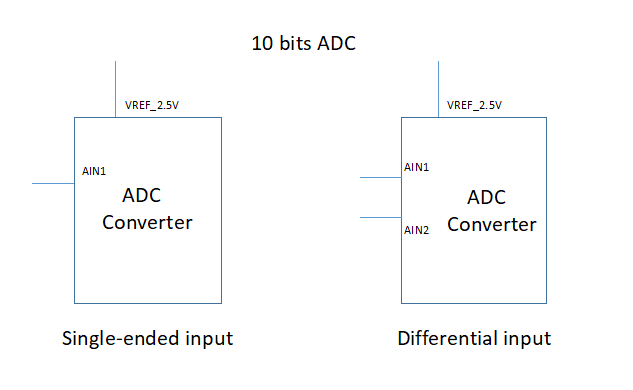 For example I have a 10 bits ADC,which has a reference voltage of 2.5V.
In single-ended mode,the input range 0-2.5V according with conversion result 0-2*e10.
And what about the differential mode?
I have two question,in differential mode,is the votage range -2.5V-2.5V?
and -2.5V-2.5V according with conversion result 0-2*e10?
Any assistance is appreciated.
For example I have a 10 bits ADC,which has a reference voltage of 2.5V.
In single-ended mode,the input range 0-2.5V according with conversion result 0-2*e10.
And what about the differential mode?
I have two question,in differential mode,is the votage range -2.5V-2.5V?
and -2.5V-2.5V according with conversion result 0-2*e10?
Any assistance is appreciated.
-
\$\begingroup\$ Which ADC are you referring to? \$\endgroup\$– hacktasticalCommented Apr 10, 2020 at 4:10
-
\$\begingroup\$ Not to specific ADC,I am just confused with the mixed relation from single-ended input and differential input to unipolar and bipolar mode. And @MarkU had give a detailed answer.Also thank for your kind anwser \$\endgroup\$– Ye ShiweiCommented Apr 17, 2020 at 8:31
1 Answer
ADC 10-bit resolution means there are pow(2,10)=1024 possible output codes.
If the transfer function is unipolar with voltage range 0 to 2.5V, then ideally each code is (2.5V)/1024=0.0024414V and the maximum full-scale voltage is (2.5V)*(1023/1024)=2.49756V. Real measurement will have some offset error and some gain error specified in the ADC datasheet Electrical Characteristics table.
If the transfer function is bipolar with 2's complement codes, with voltage range -2.5 to 2.5V (a span or dynamic range of 5.0V), then ideally each code is (5.0V)/1024=0.004883V and the maximum full-scale voltage is (5.0V)*(511/1024)=2.495117V. Real measurement will have some offset error and some gain error specified in the ADC datasheet Electrical Characteristics table. Note that in 2's complement, the 1024 possible output codes have the range -512 to +511.
If the input is single-ended that means that the input voltage is sampled with respect to analog ground (which must be close to digital ground). Usually single-ended input is used with unipolar transfer function, because the smaller LSB voltage gives more detail.
If the input is differential that means that the input voltage is sampled as the algebraic difference between two analog input pins, such as AINP and AINN. The signal would be (AINP)-(AINN). Both input pins must also be within a specified common-mode input range, such as between AVDD and AGND. If AINP is 1.5V and AINN is 2.1V, then the signal would be -0.6V, even though both AINP>0 and AINN>0. Usually differential input is used with a bipolar transfer function, so that both positive and negative signals can be encoded.
-
\$\begingroup\$ Thanks for your detailed anwser,now i realize that single-ended usually together with unipolar mode and differential input usually together with bipolar.Really a big help from you. \$\endgroup\$ Commented Apr 17, 2020 at 8:22
